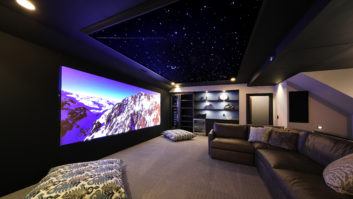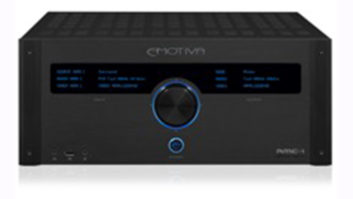It is an integrator’s ultimate fantasy: a wealthy client writes a blank check, and you get full run of a complex, large-scale project that integrates everything from a dynamic home theater to landscape lighting.
For Vancouver-based integration firm, Millson Multi-Media, this was no daydream. When a long-time, tech-savvy client wanted to outfit his vast property with a “no compromises” home cinema as well as other technological accoutrements, he called on Richard Millson, president of the firm, and his team to deliver a stratospheric experience. The results–spread across three buildings on three acres, covering 22,000 square feet of living area in Vancouver–took more than four years to complete.
Among many of Millson’s achievements on the project, the custom-built home theater stands as testament to the firm’s ingenuity and creativity in the face of difficult challenges, which included building the 6,000-cubic-foot, 15-seat cinema in an underground, concrete-encased room.

The custom-built home theater stands as testament to the Millson Multi-Media Inc.’s ingenuity and creativity in the face of difficult challenges.
“This cinema is nothing short of staggering in terms of the picture, sound, and the overall experience of being in the space,” Millson said. “There really are none of the compromises that so often we as designers and integrators have to deal with. We were able to achieve the perfect scenario in terms of all the basics, like removing background noise, achieving complete darkness, setting up ideal sight lines and seating distances, and providing the highest quality in terms of audio and video equipment.”
Molded in Stone
Concrete has its advantages. For Millson and his team, the 14-inch thick walls that surrounded the would-be theater had an upside: there was little chance sound would leak out to the rest of the home. But such incidental sound isolation was not going to cut it.
The ‘concrete box’ nature of the cinema space meant that we had to do very extensive acoustic treatment to the interior surfaces of the space in order to absorb the lower frequencies and the reflected sound in the upper frequencies,” Millson explained. “In addition, too much absorption would mean a very dead-sounding room so we also needed to include a variety of diffusive elements to allow the room to maintain a nice balance of absorption and diffusion.”

Millson and company conceptualized the installation before starting construction.
To achieve optimal acoustic isolation, the team first used two layers of dense Quietrock wallboard hung on a series of rubber isolation hangers to create an interior room that essentially “floated” off the wall and ceiling surfaces. The edges of these boards do not touch to avoid unwanted rattles, buzz, and other sounds caused by materials rubbing together. The same construction method was used with the floor and riser sections, where heavy timber was double glued and screwed together for a rigid finished platform.
In the 10.5 inches that separate the concrete surfaces from the new interior walls, a number of acoustic control treatments, designed to work as bass traps, were installed; among them mineral wool, which was employed as a free-standing barrier and to “scrub off” bass energy, as well as a large array of 2- and 4-inch absorptive panels and custom-designed, solid-wood, high-frequency diffusion panels.
“All of this treatment was very effective, and through various rounds of measurement, panel placement, and re-measurement we were able to achieve a spectacularly well-balanced room,” Millson said. “The only problem, of course, was how to hide all of this effective, but arguably somewhat ugly, acoustic treatment with an interior shell that would allow the room to appear as a warm, inviting residential environment, without compromising all of our hard work.”
The Beauty Treatment
Bass traps, foam, and absorptive materials are not attractive, so Millson and company set about creating a room-within-a-room to conceal the acoustic elements. Using a wood-and-aluminum framework replete with large sections of acoustically transparent fabric stretched across its body, the team devised a compression system that sandwiches the frame between the concrete slab above and the concrete floor below. The result is a freestanding room with the appearance of solid walls, recessed wall niches, and cherry wood trims.
To our knowledge this type of solution does not exist for sale as a product so we designed and fabricated ourselves,” explained Millson. “This allowed us to assemble the structure using rubber isolation washers to ensure that no two mating surfaces would create friction under high-volume conditions. Even the recessed ceiling lights were individually joint-filled with flexible, high-heat silicone to ensure that they would be silent as well. All of the heavy gauge pipe supports that pass through the floating ceiling to the framework do not touch the ceiling, and the edges around the pipes have also been sealed with flexible acoustic caulking.”

To achieve optimal acoustic isolation, Millson’s team used two layers of dense Quietrock wall board hung on a series of rubber isolation hangers to create an interior room that essentially “floated” off the wall and ceiling surfaces.
Silencing the Air
The dimensions and location of the home theater–massive and underground–meant that substantial cooling and heating were required. With the client stipulating that the HVAC system be neither seen nor heard, the Millson crew co-opted a storage closet 50 feet away from the cinema, where they installed a dedicated water furnace to provide heating and cooling to the theater. Using oversized, lined ductwork, the team was able to configure an air delivery system that pumped out low velocity, and therefore quiet, air to three separate zones, including the main cinema, the separate projector enclosures, and the equipment racks.
“Each of these areas is thermostatically monitored and controlled separately to allow the perfect amount of air exchange at the right temperature each,” said Millson. “We also designed and had custom fabricated a series of large aperture, low velocity, air diffusion grills all of which reside behind the acoustically transparent interior walls and ceiling so that no air handling equipment is visible anywhere in the room.”
Designer Visions
Like system integrators, interior designers have pretty high standards. For this Vancouver home theater, the ID team wanted, well, a theatrical feel, which included full height curtains across the face of the proscenium. Problem is, the curtains, if traditionally installed, would stack at each side of the screen, in effect blocking the sound from the left and right front channel speakers.
After a brainstorming session, the integration team decided to extend the curtain track into the wall space on each side of the cinema. Working with lighting control firm, Lutron, custom fabricated curved QED curtain tracks were made and installed in such a way that when open, the body of each curtain section is hidden inside the wall at the front of the room, perpendicular to the screen. In addition to creating a completely acoustically transparent front baffle wall, this custom solution gave the ID team the freedom to select a curtain fabric with out worrying about the material reflecting light and causing visual distractions.
Floating in Space
The integration team’s problem-solving skills moved beyond soundproofing and interior decorating solutions when it came time to install a Stewart FilmScreen large-format CineCurve masking screen. Not wanting to damage the hard work they had put into the acoustic isolation aspects, Millson set about building a large curved baffle wall that sits directly behind the screen.
“This wall features very extensive bracing but, again, it is supported on nothing more than a series of custom metal supports that tie directly backward to the front concrete wall and down to the floor,” Millson said. “Nothing from this front baffle wall is attached to the ceiling or the sides of the room in any way, allowing it to serve as another ‘floating’ element in the acoustic design solution.”

The team mounted three of these 23-cubic-feet custom Millson subwoofer enclosures directly to the concrete slabs.
This design trick of seemingly suspending cinematic equipment in mid-air was also applied to the matching Genelec 1034B front-channel speakers, which are supported on a welded steel platform, powder-coated black, and mounted on individual rubber isolation feet. “Each of these speaker/support combinations is a freestanding element that does not touch the front baffle wall, but allows the speaker to sit flush with the front surface of the wall with exactly one quarter of an inch of space between the edges of the speaker and the wall itself,” Millson added. This space was then filled with closed cell foam for a tight but noise-free seal.
Incredibly, the same integration magic was applied to all four of the large and heavy 18-inch custom Millson subwoofer enclosures, which are located at the front, sides, and back of the room.
“To mount these substantial enclosures in a way that would not compromise the isolation philosophy used in the rest of the space, we secured an 1.5-inch-thick Baltic birch support plate directly to the concrete slabs at each location and then devised a cleat-style support bracket for each enclosure to hang from the front of those support plates,” said Millson. “Again, these assemblies protrude directly through the walls–and in the case of the rear subwoofer, the ceiling–and do not touch the physical structure of the room in any way.”
Behind the Sleight of Hand
While the Millson team was responsible for much, much more than the design and installation of the Vancouver estate’s home theater, the creativity that went into designing and building the cinema can not be overstated. Like Chinese boxes, the effort to work within a larger framework while maintaining visual eloquence is not only challenging, but also requires experience, patience, and an acute attention to detail.
Millson credits his team’s ability to conceptually reconfigure intricate designs such as this large home cinema to their work with commercial commissions. “We have developed a skill set specifically to conquer large, commercial residential tower projects and that has allowed us to assemble the types of capacities required to handle a project like this,” he said of his firm’s experience.

Millson custom fabricated a number of high-density panel enclosures that allowed them to stack circuit boards vertically within the enclosure.
“In terms of scope and budget, this single project is equal to four or five very large custom home projects happening all at once, and that requires a very strong team.,” he added. “We are very lucky to have a group of very experienced and senior people to handle a project of this quality and complexity…This project also includes a significant number of items that were asked for by the client, but that simply did not exist.”
Llanor Alleyne is the managing editor of Residential Systems in New York City.





